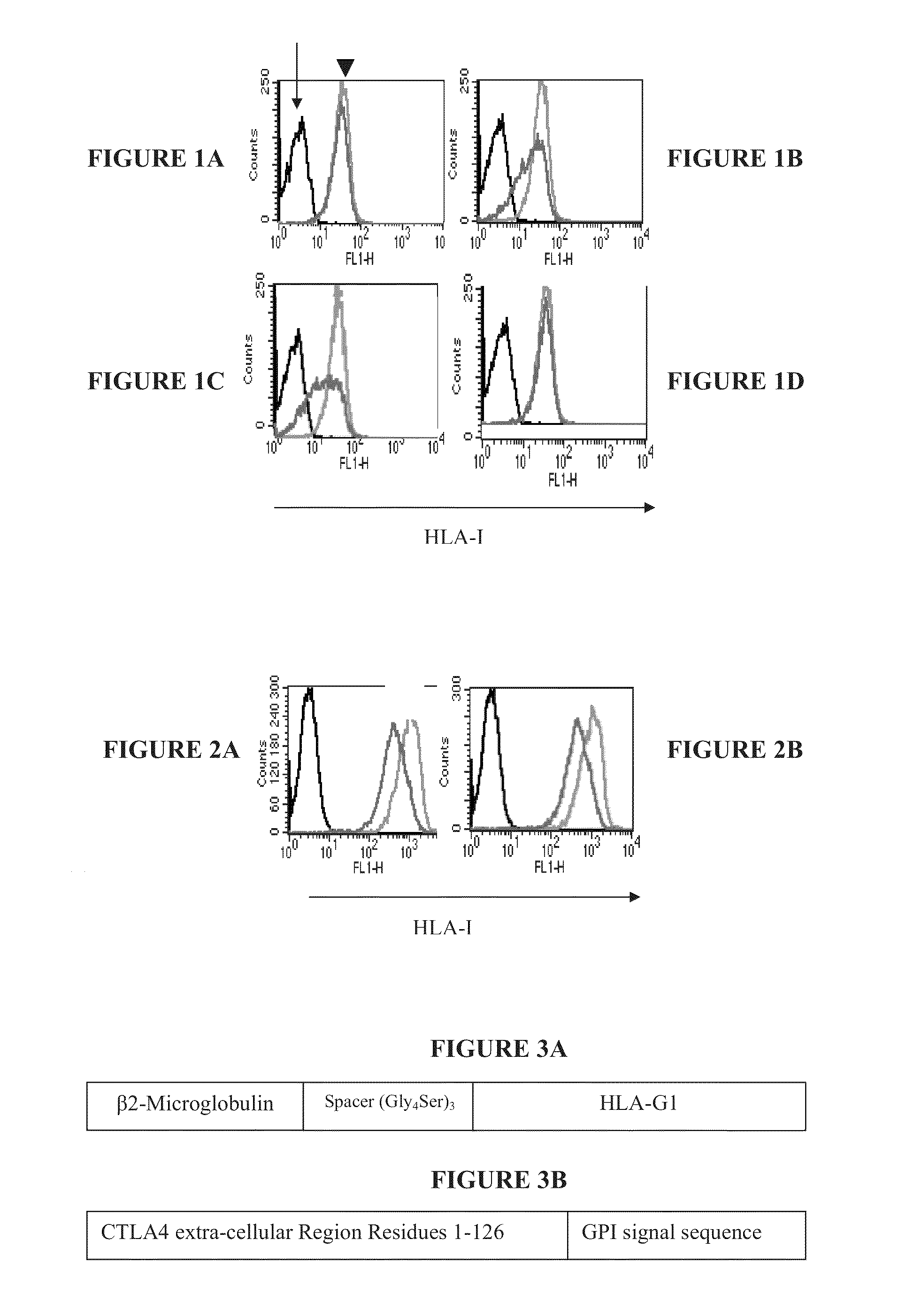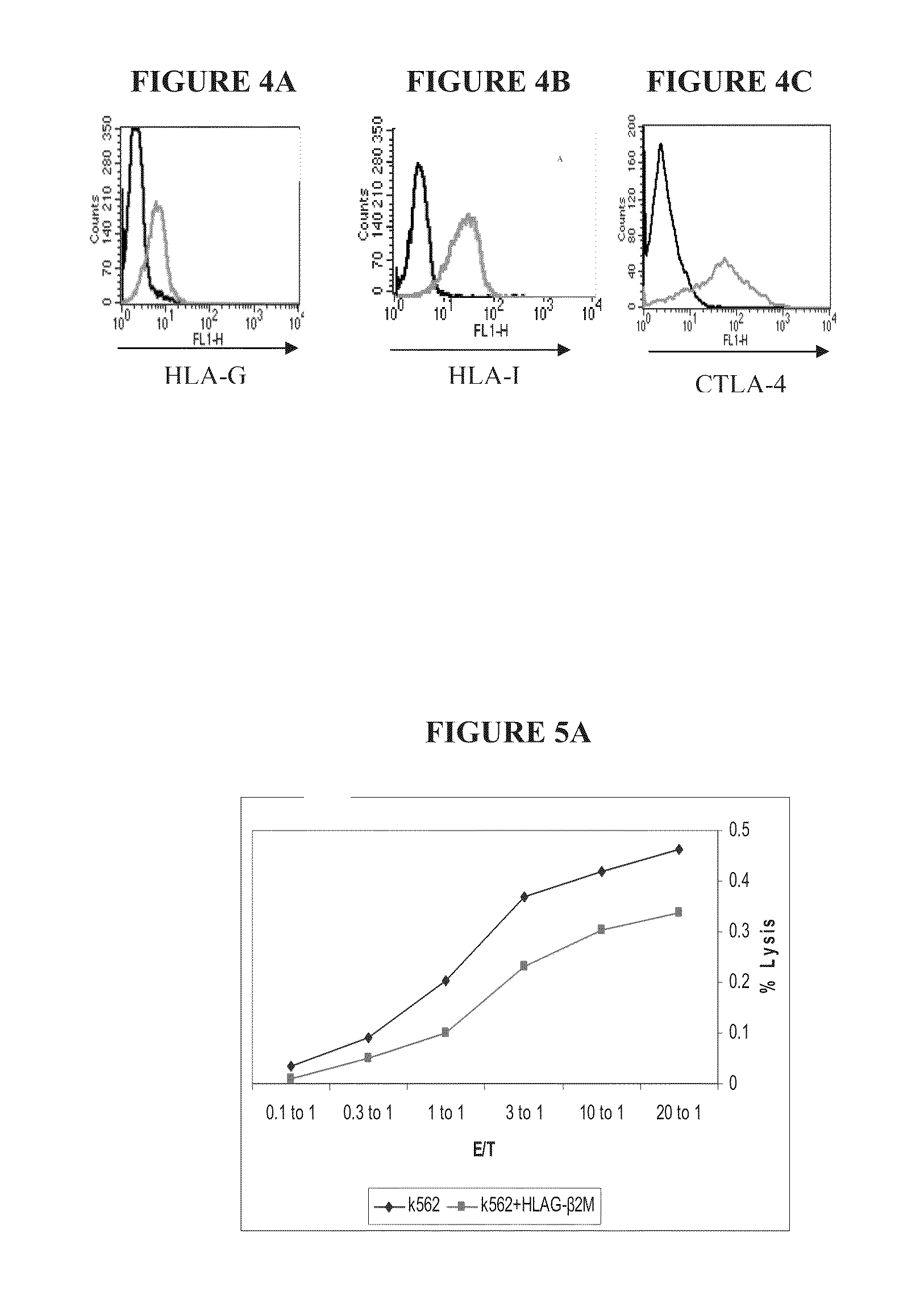Immunotherapy using redirected allogeneic cells
a technology of allogeneic cells and immunotherapy, applied in the field of immunotherapy and medicine, to achieve the effect of safe and effective adoptive transfer therapy
- Summary
- Abstract
- Description
- Claims
- Application Information
AI Technical Summary
Benefits of technology
Problems solved by technology
Method used
Image
Examples
example 1
Adoptive Therapy Using ‘Unstealthed’ Allogeneic Tumor Specific T Cells
[0136]The failure of the ‘stealthing’ approach led the inventors to seek alternative strategies to prevent the rejection of the transferred cells. One obvious method for preventing the rejection of the transferred cells is to completely ablate the host's immune system, and then rescue the host with either syngeneic or allogeneic bone marrow transplantation (BMT). The major difference between syngeneic or allogeneic BMT is that allogeneic BMT carries the risk of GvHD (even if the donor is MHC matched which is itself non-trivial). However, in the case of allogeneic ACT the difference between auto-BMT and allo-BMT is markedly blurred because the transferred allogeneic cells can cause GvHD by themselves. So in either case the major obstacle facing the lymphoblation approach is the risk of GvHD. It was surmised that the use of mild preconditioning might be sufficient to create a therapeutic time window in which the tra...
example 2
GvHD is a Function of Host Preconditioning and Cell Dose
[0137]It is well established that even a miniscule amount of allogeneic T cells present in the BM is sufficient to cause lethal GvHD, but the risk of GvHD has not been evaluated using milder conditioning protocols. Ideally, one would like to induce the most potent antitumor response without risking GvHD. Towards that end, the inventors preconditioned mice with increasing amounts of irradiation followed by transfer with variable amount of cells, in order to find the most potent adoptive transfer regimens which avoid GVHD. The inventors used activated C57BL / 6-N29 T cells as donors, and Balb / c mice as recipients. T cells were activated in vitro with concanavalin A (conA) for 48 hours, and then expanded with IL-2 for up to 5 days. Activation is critical since the inventors planned to redirect the T cells against the tumor (in subsequent experiments and in the clinic) using retroviral transduction with the TPCR (which only infect pr...
example 3
Transgenic Allogeneic T-Bodies are as Effective as Transgenic Syngeneic T-Bodies and Superior to Unmodified Allogeneic Cells in a Minimal Residual Disease Model of Cancer
[0138]After determining safe regimens for adoptive transfer, the inventors tested the efficacy of tumor rejection by CR redirected T cells. The inventors used the Renca-erbb2, renal cancer cell line, stably transfected with erbB2 (HER2) which was injected intravenously into Balb / c mice to generate experimental pulmonary metastases. As effectors, the inventors used splenocytes from transgenic mice expressing a HER2 specific chimeric receptor (based on the N29 antibody derived scFv, FIGS. 7A-B) under the CD2 promoter (which is expressed in T and NK cells [8]). The HER2-specific transgenic mice were kept on two backgrounds: C57B1 and Balb / c (named C57B1-N29 and Balb-N29 respectively). Wild type Balb / c mice were injected with the Renca-erbb2 on day 1, irradiated on day 7, and HER2 specific T-bodies were injected on day ...
PUM
| Property | Measurement | Unit |
|---|---|---|
| diameter | aaaaa | aaaaa |
| median survival time | aaaaa | aaaaa |
| median survival time | aaaaa | aaaaa |
Abstract
Description
Claims
Application Information
 Login to View More
Login to View More - R&D
- Intellectual Property
- Life Sciences
- Materials
- Tech Scout
- Unparalleled Data Quality
- Higher Quality Content
- 60% Fewer Hallucinations
Browse by: Latest US Patents, China's latest patents, Technical Efficacy Thesaurus, Application Domain, Technology Topic, Popular Technical Reports.
© 2025 PatSnap. All rights reserved.Legal|Privacy policy|Modern Slavery Act Transparency Statement|Sitemap|About US| Contact US: help@patsnap.com



